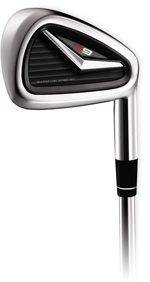 TaylorMade seems to have made it its mission in recent years to reinvent what the phrase “classic golf club” means. For example, they have taken the pear-shaped driver and morphed it into a geometrical tinker toy that looks both modern and classic at the same time. Now, their researchers and designers have turned their attention to creating a classic/modern iron.
TaylorMade seems to have made it its mission in recent years to reinvent what the phrase “classic golf club” means. For example, they have taken the pear-shaped driver and morphed it into a geometrical tinker toy that looks both modern and classic at the same time. Now, their researchers and designers have turned their attention to creating a classic/modern iron.
Given the success of the r7 line, the expectations for the TaylorMade R9 line could not be much higher. Is it possible for a club to gain 10% of distance over the already long r7? Can the R9 improve its forgiveness while incorporating several characteristics of a classic golf club? Can a game-improvement club have a soft feel? Since the initial announcement, the forum has been buzzing with golfers interested in whether the R9s can truly live up to those expectations. Read on to see some the answers that I found to those questions.

 When you are setting up to a “classic” iron, what kinds of thoughts run through your mind? For me, I imagine the silky smooth feel of the sweet spot. I visualize the ball curving through the air at will. I can almost see the ball falling to the green with just enough spin to bounce twice and then stop. However, put a blade in another player’s hands and the reaction could be entirely different. They might look down desperately searching for that microscopic sweet spot, trembling at the thought of the painful reverberations of a mis-hit.
When you are setting up to a “classic” iron, what kinds of thoughts run through your mind? For me, I imagine the silky smooth feel of the sweet spot. I visualize the ball curving through the air at will. I can almost see the ball falling to the green with just enough spin to bounce twice and then stop. However, put a blade in another player’s hands and the reaction could be entirely different. They might look down desperately searching for that microscopic sweet spot, trembling at the thought of the painful reverberations of a mis-hit. Among the giants of the golf industry,
Among the giants of the golf industry,  Frank Razzaia is a 4.0 index golfer hoping to build a more reliable, tournament ready swing. At normal speed, I am a big fan of Frank’s swing. However, watch his swing frame by frame and you will notice he lacks one of the most important attributes in golf: lag.
Frank Razzaia is a 4.0 index golfer hoping to build a more reliable, tournament ready swing. At normal speed, I am a big fan of Frank’s swing. However, watch his swing frame by frame and you will notice he lacks one of the most important attributes in golf: lag.